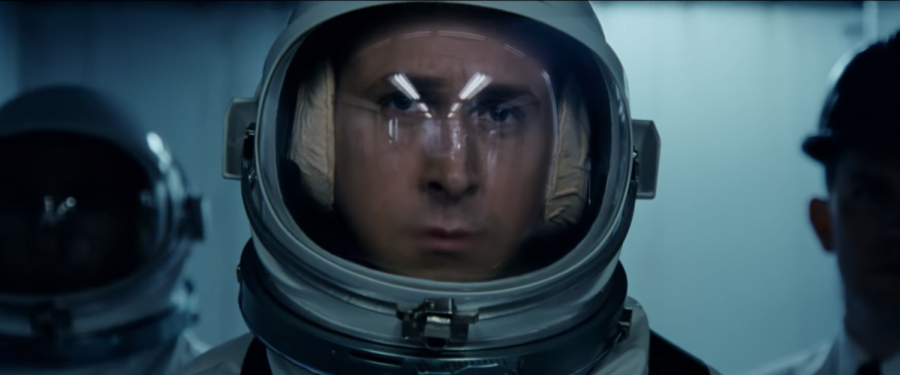“First Man”: a soaring yet intimate portrait
November 4, 2018
While many biopics concern themselves with showing all of the major events of a famous figure’s life, director Damien Chazelle takes a different route in “First Man”. We follow Neil Armstrong, played by Ryan Gosling, as he joins NASA and the space race as well as the 1969 moon landing.
The film takes a unique angle that explores Armstrong the man rather than his achievements in space exploration. The purpose of the film is not simply to recreate historical events we are already familiar with. Chazelle wants us to show us the emotion behind them.
The emotional center of the film is the death of Armstrong’s daughter, Karen, who passed away from a tumor at the age of two. Karen’s existence and death were little known to Armstrong’s colleagues at the time, as he was very reclusive. Through this tragic event, an emotional connection is established at the beginning of the film between Armstrong and the audience.
While many writers would end a Neil Armstrong film with a celebration, “First Man” writer Josh Singer chooses otherwise. The film ends with Neil in quarantine, as was NASA protocol for astronauts returning from the moon, meeting his wife Janet. We do not see a hero’s welcome for Armstrong.
“It didn’t [feel appropriate] to end the movie with just nothing but cheering crowds and people getting their pictures taken,” Chazelle said in an interview with NPR. “[There] had to be some acknowledgement, in a way, of just the immense sacrifice [without which] we wouldn’t have had [the space landing].”
Another reason that Armstrong is relatable in this film is Ryan Gosling’s performance; he becomes Neil Armstrong. Gosling acts reserved on the surface, much like Armstrong was, yet the emotion comes through in small moments, such as when Armstrong breaks down after his daughter’s death. All of the scenes where Armstrong plays with his children are simple yet touching. We better understand Armstrong by seeing his home life as well as his work at NASA.
Gosling’s acting feels genuine, which cannot be said of the rest of the cast. Claire Foy is passable as Janet, but she does not inhabit her character as Gosling does. The rest of the supporting cast fades into the background. Kyle Chandler plays Deke Slayton, one of the original Mercury Seven astronauts, and Jason Clarke plays Ed White, who died in testing for the first Apollo mission. In the film, the two are indistinguishable. Chazelle spends too much time between spaceflights showing the camaraderie between Armstrong and his fellow astronauts on Earth. The dialogue is stale and does not further the audience’s understanding of Armstrong.
The film is also unsuccessful in addressing public frustration with the space program. For example, we hear the song “Whitey on the Moon” by Gil-Scott Heron, which criticized the American government for funding an expensive space race in a time of racial and economic inequality. However, the film does not commit to expressing this duality, nor does it show how these public criticisms affected Armstrong.
“First Man” has not performed well at the box office. It made only $16 million opening weekend against an almost $60 million production budget. The film is much more serious than Chazelle’s previous film, “La La Land” and faced competition from “A Star Is Born” as well as “Venom.”
Furthermore, there was political controversy surrounding the film. Conservatives, including Florida senator Marco Rubio, took issue with the fact that the film did not not show Armstrong planting the American flag into the lunar surface, even though the flag is very visible during the moon landing sequence.
In spite of the film’s issues and the controversy around it, the action sequences are riveting. The amount of camera movement and different angles Chazelle was able to get in such small spaces is impressive. In all of the flight sequences involving Armstrong, the audience knows that he will survive. Yet, Chazelle, with Justin Hurwitz’s booming yet melodic score, is able to build tension effectively, especially during the Gemini 8 mission and the moon landing.
Once we are on the moon, Chazelle shows us Armstrong’s point of view of coming down the ladder, taking that first step, and eventually the lunar surface. The audience is quite literally put in Armstrong’s shoes. Rather than focusing on the vastness of the moon, Chazelle keeps us emotionally centered on Armstrong with tight, closeup shots.
The film also is surprisingly historically accurate, both in terms of the chronology of the space race as well as Armstrong’s home life. Armstrong’s sons, Mark and Rick, who also appear as children in the film, praised “First Man” for its accurate portrayal of their father. The only noticeable historical inaccuracy is during the moonwalk, where Armstrong tosses a bracelet with Karen’s name on it into a moon crater. This probably did not happen, but Armstrong’s sister thinks that Karen was on his mind when he was on the moon. In other words, she believes that even on the moon, Armstrong was grieving his daughter’s death.
“As we did more and more research, the movie [shifted] from a [movie] about the race to the moon to a movie about grief and coping,” Chazelle said in the same interview with NPR.
This unique angle on Neil Armstrong that Chazelle took is its biggest strength. It is different from any of Chazelle’s previous work, but still deals with themes of dreams and ambition as he did in “Whiplash” and “La La Land.” While some may think that there is not much else to Armstrong’s story, “First Man” argues otherwise. It demystifies Armstrong and shows us that the first man on the moon was, just like anyone else, a person.




